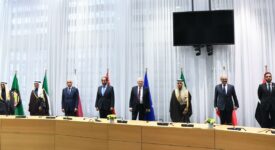The MENA region is growing fast and most of the key challenges of the coming decades are tied to the population itself. By the end of the century, the MENA region will host double the number of people in Europe and at the same time, the MENA region is going to grow older. Approximately 46% of the MENA region today is below the age of 24, and this number will only increase due to the drops in fertility rate. Over the course of the century, the bulk of people (47%) will be middle-aged (25–64) and the number of youngsters is projected to drop to 27% by 2100. Most of the population growth will occur in Egypt, Iraq and Sudan, which will account for roughly half of the MENA population by 2100.
The river basins of the regions will become resource choke points during this century as demography and the security of environmental resources collide. Given limited arable land and water resources, the nexus between the environment and population will be exceedingly important. Agricultural expansion potential in the region is close to zero due to a lack of water resources and limited arable land. MENA region is already home to the water-scarcest countries on earth and while Turkey won’t be as affected by these changes, the rest of MENA countries will suffer an absolute water scarcity, which means water availability will decrease to 500m3 per year per person. With water becoming a resource, the MENA region will require a dramatic change in terms of food and water supply to mitigate these new risks.
Another issue is the increased demand for water resources in urban areas. The number of MENA citizens living in cities will increase from 50% today to 70% of the total population by 2050. Urban areas will have to absorb more people and secure more food, water, energy and ultimately livelihoods to meet the demands of future populations. Apart from Turkey and Israel, the MENA region is not prepared for these shifts. The very limited potential of domestic agricultural production will increase the dependency of the MENA region on food imports, because the current strategies aimed at increased domestic food production are unlikely to be successful.
On the other hands, unemployment rates in the region are high, particularly youth unemployment, with detrimental effects on the educational and economic well-being of the coming generations. The educational systems require reform measures to increase employability of young MENA citizens in the private sector. At present, the young generation is still largely seeking employment in the oversized public sector, which cannot provide career opportunities for all young people.
An important choke point will be the energy sector. While the MENA region will continue to remain a very significant provider of hydrocarbons to the world market, energy trends are shifting from fossil fuels to renewables. At the same time, absolute population growth will mean more domestic energy demand. The MENA region has a formidable renewable energy potential if wind and solar power opportunities are effectively utilized. If properly handled, the energy sector can help to transform the region by increasing regional cooperation and by aiding resource-efficient, industrial development in order to create secure jobs.
The militarization of the region will prove to be one of the most challenging choke points, as the whole MENA region is heavily securitized. It will require some substantial diplomatic skills if we are to avoid any military conflict. Public spending on the military remains high, but peace and stability are still just empty promises. What is worse is that with high military spending, countries divert their financial resources from future-oriented investments such as job creation or infrastructure, which should be the areas of their primary focus.
In conclusion, the MENA region in 2018 is fraught with political, environmental, economic, demographic and military choke points that require urgent attention by domestic and foreign policymakers. Suitable investment strategies need to go hand in hand with effective diplomatic initiatives to ensure the region is fit for the global future.
‘Material Choke Points in the MENA Region’ – Policy Brief by Martin Keulertz, Mark
Mulligan, Musa McKee and Eckart Woertz – Barcelona Centre for International Affairs / CIDOB.







